Chihuly Exhibit at Biltmore
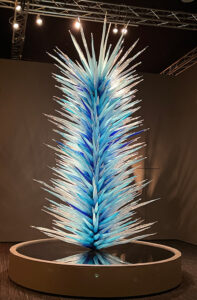 We recently made a trip to the Asheville area for some family business, but we also had some time for a side trip to Biltmore House and, especially, to see the Chihuly glass art exhibit.
We recently made a trip to the Asheville area for some family business, but we also had some time for a side trip to Biltmore House and, especially, to see the Chihuly glass art exhibit.
Note: click on all pictures for a larger version.
I’ve long loved glass works and been fascinated by the process of glass blowing and shaping. The way light plays around and through the material is endlessly intriguing.
 As an artistic medium it has an enormous range of possibilities. And I don’t know of anyone who has explored and pushed the limits of the art of glass-working as much as Dale Chihuly.
As an artistic medium it has an enormous range of possibilities. And I don’t know of anyone who has explored and pushed the limits of the art of glass-working as much as Dale Chihuly.
Seeing some of his masterworks was truly awe-inspiring. The range of imagination and the creativity on display simply overwhelmed. So many forms, colors, textures, sizes, and embedded designs made a feast for the eye. Even more, they invited and repaid closer study with subtle detailing and intricate mixes.
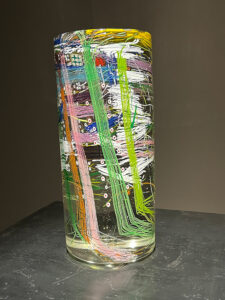 My pictures can’t do these works of art justice. They have a weight, a presence, a bit of humor in their inspiration that compels attention.
My pictures can’t do these works of art justice. They have a weight, a presence, a bit of humor in their inspiration that compels attention.
The cylinders and soft cylinders are delightful with their brilliant, eccentric shapes and unique embedded designs. The trees and chandeliers, made from hundreds of narrow glass tubes, are a visual delight.
The Persian ceiling looms above you and bathes you in a gorgeous array of colors and patterns filtering the light above it. The effect is stained glass on steroids, allowed to go beserk, yet never forgetting its mission to be beautiful.
But beyond every other piece or grouping, the enormous Mille Fiori is truly the masterpiece. It was displayed in a large room of its own with a number of benches scattered around, because it’s the kind of piece you want to sit and spend some time with.
It features possibly a hundred or so square feet of alien garden composed of individual glass pieces, sculpted into a huge variety of shapes, curves, textures, colors, sizes, and opacities. The colors are rich and saturated, vivid and glowing. Lit from above, in a mostly dark room, set on a reflective black surface, it’s so compelling you almost want to climb into and revel in the world it creates.
That’s discouraged, of course, and the impulse is counter-balanced by a reluctance to harm the perfection of the various pieces.
As a writer, I instinctively feel there must be lessons I can glean from the piece that I can apply to my writing. What are the analogues for brilliant color in unlikely combinations that shouldn’t work but do? How do I present so many varied forms, shapes, and textures through the medium of words? Does each separate piece stand in for a character? A scene? A bit of dialogue? How does the tension between curves, corkscrews, shallow bowls, and straight uprights work to produce a piece with wild variations and a sense of completeness?
Oddly, seeing the Mille Fiori has given me some ideas for how to approach editing a manuscript I recently completed, one which I know has problems. The work has me considering whether each bit of dialogue, paragraph of narration, suggestion of characterization, action sequence, etc. is as polished and deeply textured as I can make it. And does it blend in with the overall whole both smoothly, but not too smoothly — in a way that generates tension toward creating a cohesive whole?

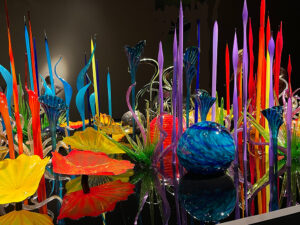 I’ve realized that I sometimes indulge in lazy writing. I take the easy, shallow way to bring a story to life, showing just the surface, instead of digging into it for the deeper, richer color or more intriguing shape. I smooth over the competing rough textures instead of seeking to rub them together for the sparks they could generate.
I’ve realized that I sometimes indulge in lazy writing. I take the easy, shallow way to bring a story to life, showing just the surface, instead of digging into it for the deeper, richer color or more intriguing shape. I smooth over the competing rough textures instead of seeking to rub them together for the sparks they could generate.
But that’s what rewrites are for. The first draft gets the story down on paper. Revisions explore the nooks and crannies and unexpected twists and turns, sharpening the shapes, smoothing the curves, finding the different textures, and making the rich colors glow. I hope I can carve up, polish, and reshape this work into something far better than it is now.
I’ve uploaded more pictures from the exhibit to my Facebook feed at https://www.facebook.com/karenmccullough

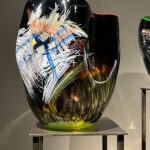

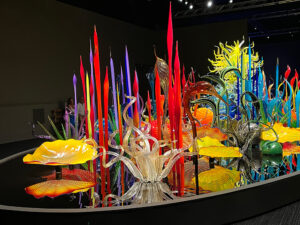
What a lovely meditation, on creation and writing! It reminded me of the need to continue seeing art (as well as reading it and hearing it): we pick up writing ideas, wherever we go–so why not from beautiful and thought-inspiring things?
Thank you, Karen.
These are so beautiful 😊